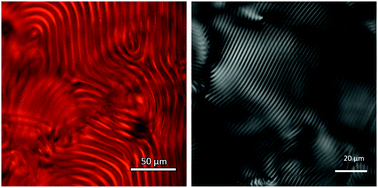A chiral–racemic lyotropic chromonic liquid crystal system†
Abstract
The two main classes of liquid crystals are thermotropic (containing no solvent) and lyotropic (containing solvent). Both of these classes possess the nematic phase, the most simple of liquid crystal phases with only uniaxial orientational order. For both of these classes, if the constituent molecules are chiral or if a chiral dopant is added, the preferred direction of orientation rotates in helical fashion in what is called the chiral nematic phase. Recent research has shown that because the ordering entities of the two classes are quite different (molecules versus molecular assemblies), important differences in the properties of the nematic phase can result. While thermotropic chiral nematics have been extensively examined, less is known about lyotropic chiral nematics, especially for the most ideal case, a chiral–racemic system. Furthermore, none of the lyotropic chiral–racemic studies has included lyotropic chromonic liquid crystals, which are solutions of dyes, drugs, and nucleic acids. Inverse pitch measurements are reported for a chiral–racemic system of a chromonic liquid crystal across the entire chiral fraction range and over a 30 °C temperature interval. The inverse pitch depends linearly on chiral fraction and decreases with increasing temperature, indicating that achiral and chiral molecules participate in the assembly structure similarly. The helical twisting power is significantly larger than for other chiral lyotropic liquid crystals due to the very high scission energy of the investigated system.



 Please wait while we load your content...
Please wait while we load your content...